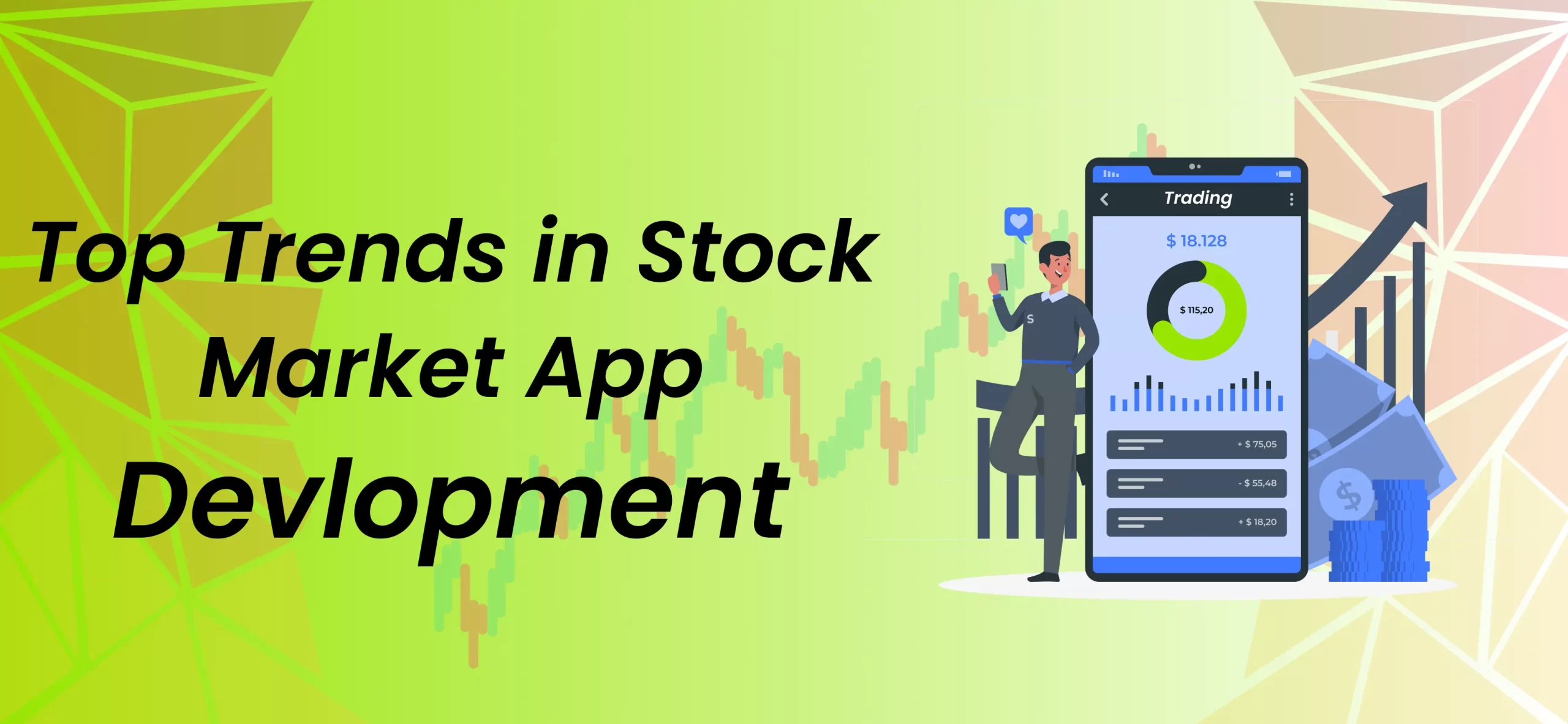The best stock market app and trading software solutions allow users to buy and sell stocks, invest in stock trading app development company, and analyze market trends with ease. Leading fintech app development firms specialize in AI-powered solutions, creating robust stock trading platforms with a reliable technology stack to ensure seamless performance. Whether you’re looking for free trading options, share trading software, or the best application for trading, the right software development approach can make all the difference. Many top app development companies focus on cross-platform solutions, enabling investors to access their portfolios from anywhere. Features such as portfolio management, real-time stock price app updates, and AI-driven insights help traders make informed decisions. If you’re looking to build a stock trading application, choosing a company with expertise in market app development and a strong tech stack is crucial. The best investment apps also offer features like cryptocurrency trading, SIPC-backed security, and user-friendly interfaces to ensure a seamless experience for investors of all levels.
Today, stock markets have never been more accessible thanks to mobile applications and smartphones. Millions of individuals worldwide now actively engage with the stock market through smartphones as an alternative method. This phenomenon highlights modern stock market apps’ convenience and accessibility – investors of any experience can now easily buy, sell, and track investments with just a few taps on their screens anywhere, anytime.
Accessibility has democratized investing and catalyzed rapid innovation within stock market app development. Developers constantly work toward providing users with more sophisticated features, enhanced user experiences, and secure applications that meet modern security standards.
This blog seeks to shed light on the latest trends in stock trading apps and advancements shaping today’s market and offer insight into what investors should anticipate over the years ahead. We will analyze advancements shaping today’s market while looking forward to what investors can expect regarding stock trading app developments.
6 Popular Stock Market App Development Trends In 2025

Trend 1: AI and Machine Learning Integration
Trade your way with Charles Schwab’s AI-powered and feature-rich stock trading platform, designed for seamless access across devices. As one of the top trading platforms, Schwab’s trading app supports stocks and other investable securities with no hidden fees or minimums, making it one of the best online investment platforms for all types of investors. The mobile trading application simplifies portfolio management, allowing users to buy and sell stocks, track market trends, and access real-time stock reports.
Schwab’s best stock broker mobile app offers advanced tools, including share trading software, real-time stock price app updates, and AI-driven analysis. With a strong technology stack and expertise in fintech app development, the app provides a seamless cross-platform experience. Investors looking to build a stock trading solution can learn from Schwab’s robust tech stack and innovative approach.
The brokerage also offers StreetSmart Mobile, a sophisticated trading software for experienced traders, though it’s not always the best trading solution for the most active users. However, with Schwab now owning TD Ameritrade and thinkorswim—both recognized as some of the best trading apps—users have access to industry-leading tools for active trading.
Modern stock market apps go beyond providing basic market data by harnessing advanced analytics for deeper user insights.
Real-Time Data and Market Insights
- Provide Real-time Stock Quotes and Market Data: Real-time stock quotes and market data are the cornerstone of any trading app, as users require immediate information for timely decisions.
- Integration With News Feeds and Financial News Sources: Staying abreast of market-moving news can be challenging; as an aid for keeping informed, apps have increasingly integrated with credible financial news sources and provided personalized news feeds that correspond with users’ portfolios or interests.
- Advanced Charting Tools and Technical Indicators: Sophisticated charting tools with various technical indicators (such as moving averages, RSI, and MACD ) have become mainstream tools that enable traders to perform technical analysis and identify potential trading opportunities.
AI-Powered Insights and Recommendations
- AI and Machine Learning for Customized Investment Recommendations: Artificial intelligence and machine learning algorithms are being deployed to analyze vast amounts of data to provide customized investment recommendations based on risk tolerance, investment goals, and an individual’s past behavior.
- Sentiment Analysis in News and Social Media: AI in stock trading app development can analyze financial news articles and social media conversations to measure market sentiment and identify emerging trends – providing invaluable context for investment decisions.
- Risk Evaluation Tools and Portfolio Optimisation Solutions: Apps now provide tools that allow users to assess the risk profile of their investments and suggestions on optimizing them to meet both risk tolerance requirements and financial goals.
Trend 2: Enhanced User Experience (UX) and User Interface (UI)
Every stock market app’s success depends on providing users with a positive and enjoyable experience. In today’s fiercely competitive landscape, offering a seamless trading app with cutting-edge features is essential. This includes advanced stock trading software, AI-powered insights, and real-time market updates to position an app among the best trading apps available.
To stand out in the online stock market, developers must focus on superior fintech app development, integrating intuitive trade app functionalities, and ensuring compatibility across devices for a true best mobile trading app experience. The demand for top trading platforms continues to grow, with investors seeking the best stock trading app for convenience, security, and advanced analytics. Additionally, integrating a best share market news app feature helps users stay informed about market trends, enhancing their decision-making process.
With more traders exploring free day trading and looking for the best online investment platform, the need for a sleek and high-performing UI/UX is no longer optional—it is integral to long-term success in today’s digital marketplace.
A. User-Friendly Design
- Emphasis on Clean and Uncluttered Interfaces: Gone are the inundating interfaces filled with complex jargon and excessive information. Modern stock market apps prioritize an uncluttered design focused on clarity and user understanding, enabling a quick grasp of essential information without feeling overwhelmed – such as apps with plenty of white, legible font, and intuitive icons.
- Easy Navigation and Accessibility for Users of All Experience Levels: Our aim is to make our app accessible for both experienced traders and individuals new to investing. This requires intuitive menus, clear labeling of features, and logical information architecture – search bars are essential in providing ease of use.
- Apps Provide Customizable Views and Dashboards: Recognizing that each investor has specific needs and preferences, more apps are offering customizable dashboards that enable users to configure what information they see instantly, such as portfolio performance, watchlists, or preferred market indicators – helping improve efficiency while meeting individual investment strategies. This level of personalization enhances efficiency.
B.Gamification and Interactive Elements
- Engaging Users through Game-Like Features: To make finance less daunting, some apps now add game-like elements in the form of badges earned for completing educational modules, virtual trading challenges, or friendly competition among other users. Such features make learning about and participating in financial markets much more engaging.
- Interactive Tutorials and Educational Content: For many investors, understanding the fundamentals of investing can be challenging. Modern apps offer interactive tutorials, quizzes, and educational modules within their platform to make these complex subjects easily digestible and help inform decision-making by users.
- Virtual Trading and Simulated Portfolios: Allowing novice traders to practice trading using virtual money is an invaluable feature of beginner platforms, while risk-free portfolios provide a risk-free environment to learn market dynamics, test different strategies, and develop confidence before investing real capital in any investment opportunities.
Trend 3: Real-Time Data and Advanced Analytics
Modern stock market apps go beyond basic functionality by employing sophisticated analytics to provide users with additional insight and facilitate more informed decision-making.
Real-Time Data and Market Insights
- Deliver Live Stock Quotes and Market Data: An essential expectation of any trading app is providing accurate stock quotes in real-time – this includes current price, day’s high/low/closing price (if available), volume traded (if relevant), etc. Users rely on real-time information like this to monitor investments as they unfold or identify potential opportunities or risks in real-time.
- Advanced Charting Tools and Technical Indicators: Basic line and bar charts no longer suffice for serious investors; modern apps provide access to advanced charting tools and indicators that go far beyond mere line and bar graphs. Users can access various chart types (candlestick, OHLC), customize timeframes (intraday, daily, weekly, and monthly), overlay moving averages such as moving Averages (MA), Relative Strength Indexes (RSIs), Moving Average Convergence Divergence Divergences (MACDs), Bollinger Bands for added effect.
AI-Driven Insights and Recommendations
- Artificial Intelligence and Machine Learning for Tailored Investment Recommendations: Artificial Intelligence and Machine Learning can revolutionize investment decisions. Apps now utilize these technologies to analyze vast datasets such as historical price data, financial news stories, economic indicators, and user behavior data – offering personalized investment recommendations suited for individuals’ risk profiles, goals, and preferences ranging from specific stocks being suggested up to diversifying a portfolio.
- Sentiment Analysis in News and Social Media: Understanding market sentiment is integral to accurately anticipating price movements. AI-powered sentiment analysis tools within apps provide users with insights into whether current sentiment is bullish, bearish, or neutral to determine potential market direction better.
- Risk Analysis Tools and Portfolio Optimization Suggestions: Proper risk management is at the core of investing, which is why modern apps offer sophisticated risk analysis tools that enable investors to assess the current state of their portfolio’s exposure – this might involve factors like diversification, volatility, and individual stock risk analysis. Furthermore,
AI offers portfolio optimization suggestions by suggesting changes that better fit individual holdings, aligning more closely with the user’s risk tolerance and financial goals, potentially improving overall portfolio performance.
Trend 4: Security and Blockchain Integration
An industry that deals with sensitive financial data needs to prioritize security and regulatory compliance as top priorities.
Comprehensive Security Measures
- Implement Multi-factor Authentication and Biometric Login: Utilizing multi-factor authentication (MFA) and biometric login (fingerprint or facial recognition) provides additional protection to user accounts from unapproved access.
- Encrypting Sensitive User Data: For security, all sensitive user information, including personal and financial details, is encrypted both during transit and storage to safeguard against potential data breaches.
- Compliance With Data Privacy Laws: Apps should comply with various data privacy regulations (e.g., GDPR or CCPA) to ensure they handle and secure user data responsibly and protect it appropriately.
Regulatory Adherence
- Adherence to Local and International Financial Regulations: Stock market apps must adhere to domestic and international financial regulations. This means abiding by rules regarding trading, reporting, financial conduct, and more.
- Transparency of fees: Provide an upfront breakdown of all costs associated with using your app for user trust and regulatory compliance purposes so users understand exactly what their payments cover.
Trend 4: Social Trading and Community Features
Social media’s rise has altered how individuals engage with almost everything – including investment. Here are some of the social trading features in stock apps you need to know
Sharing and Collaboration on Social Networks
- Allowing Users to Share Trades and Investment Strategies (With Privacy Considerations): Some apps enable users to share trades and investment strategies among themselves, creating an atmosphere of community while encouraging peer learning. Nevertheless, privacy controls must always be in place to safeguard individual investment decisions.
- Building Communities and Forums for Investors: In-app communities and forums allow investors to discuss market trends, share insights, and learn from each other – an invaluable resource both novices and veteran investors can utilize.
Copy Trading and Following Expert Investors
- Features that Enable Users to Steal Trades of Expert Investors: Copy trading capabilities enable less experienced investors to mimic or copy trades executed by more seasoned or successful traders in an automated manner to learn and capitalize from their expertise. This feature is beneficial when your skillset needs updating and learning new material quickly and consistently.
- Transparency and Performance Tracking for Followed Traders: Copy trading requires providing users with complete transparency regarding the performance and track records of those they follow so they can make informed choices regarding whom to follow. This enables informed decisions from potential investors about who to follow or not follow.
Trend 5: Integration and Cross-Platform Compatibility
Users expect a seamless and accessible experience across their devices. Due to this, cross-platform stock trading app development has become a popular trend.
Multi-Device Accessibility
- Reaching Audience on Both iOS and Android Platforms: As most users utilize an iPhone or an Android phone, any successful stock market app must be optimized to work seamlessly across both platforms for optimal audience reach.
- Optimized Performance across Different Devices and Screen Sizes: Your app must perform smoothly and efficiently across various devices, from smartphones to tablets, while accommodating different screen sizes for an optimal user experience.
Integration With Other Financial Tools
- Integration With Banking Apps and Other Financial Management Tools: Integrating users’ banking apps and other financial management platforms gives them a holistic view of their finances, simplifying managing investments and other economic activities.
- Offering an Overview of Users’ Finances: By integrating with other financial tools, this app provides a holistic overview of a user’s economic status, including investments, savings, and spending habits.
Trend 6: Micro-Investing and Fractional Shares
Accessing the stock market by more people with smaller capital amounts has become an increasing focus in app development.
Micro-Investing
- Lowering the Barrier to Entry: Traditional investing often requires purchasing whole shares of stocks from high-value companies at once; micro-investing apps reduce this barrier to entry by enabling investors to begin investing with tiny sums – sometimes only several dollars at first! – making investing accessible even to beginners with limited disposable income and those starting.
- Micro-Investing Apps Undemocratic Access to the Market: These micro-investing apps democratize access to the stock market by making micro-investing more accessible, giving more individuals a chance to participate in wealth creation and benefit from its potential growth – especially appealing for younger generations just starting their financial journeys.
Fractional Shares
- Acquiring High-Priced Stocks Affordably: Fractional shares offer users an affordable way of investing in expensive stocks, such as tech giants or blue chip firms, that may otherwise be out of reach for many small investors. Instead of purchasing one whole share at a $1000 price point, fractional shares allow users to acquire fractions – for instance, 0.1 of one. This could enable smaller investors to buy these high-priced securities which might otherwise be out of their price range; for example, instead of purchasing whole shares at $1000 stock price instead, say 0.01 of the entire investment – offering cost-effective investment into these stocks that might otherwise out of reach of small investors looking for investment returns in terms of market liquidity or volatility.
- Diversifying Portfolios More Efficiently: Fractional shares allow investors with smaller capital to diversify across a wider array of companies with lower share prices than their initial portfolio investments, helping to lower risk exposure from investing solely in one sector or industry.
- Increased Flexibility and Control: Fractional shares allow investors greater freedom when building a portfolio, as investors can allocate certain sums of money directly into different stocks regardless of full share prices, giving more precise control of investment strategy and portfolio allocation.
Conclusion
As our exploration of the top trends shaping the future of online stock market and stock trading apps continues, it has become abundantly clear that the industry is undergoing a profound transformation. With the rise of AI-powered solutions, app development companies are innovating to create the best stock trading app experiences. Features like free day trading, real-time insights, and personalized portfolio management are making it easier than ever to buy and sell stocks.
These trends are set to revolutionize investing. AI-driven analytics enhance decision-making, while market trends and fintech app development foster greater financial inclusion. The growing demand for cross-platform solutions ensures seamless access across devices, and heightened security measures protect user assets in every stock market app.
Are you searching for cutting-edge solutions in trading software and best trading apps? Partner with Echoinnovate IT! Our expertise in stock trading platform development, technology stack optimization, and market app development ensures that we deliver high-performance solutions tailored to your needs. Whether you’re looking to build a stock trading application, develop a trade app, or create the best share market news app, we have the expertise to bring your vision to life.
Reach out to Echoinnovate IT today and take the next step toward launching a powerful best mobile trading app!



